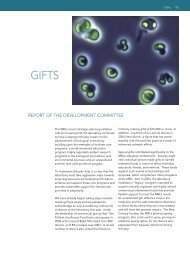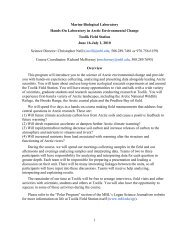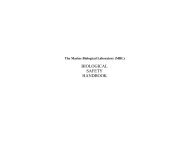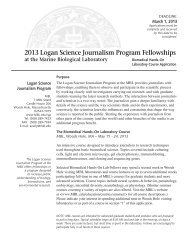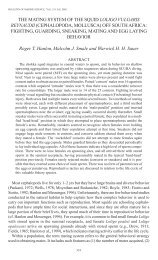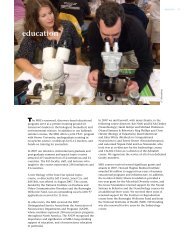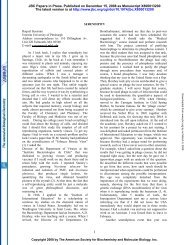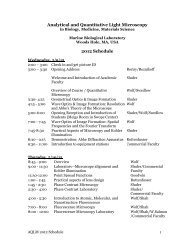An Ethogram of Body Patterning Behavior in the Biomedically and ...
An Ethogram of Body Patterning Behavior in the Biomedically and ...
An Ethogram of Body Patterning Behavior in the Biomedically and ...
Create successful ePaper yourself
Turn your PDF publications into a flip-book with our unique Google optimized e-Paper software.
Reference: Biol. Bull. 197: 49-62. (August 1999)<br />
<strong>An</strong> <strong>Ethogram</strong> <strong>of</strong> <strong>Body</strong> <strong>Pattern<strong>in</strong>g</strong> <strong>Behavior</strong> <strong>in</strong> <strong>the</strong><br />
<strong>Biomedically</strong> <strong>and</strong> Commercially Valuable Squid<br />
L&go pealei <strong>of</strong>f Cape Cod, Massachusetts<br />
ROGER T. HANLON, MICHAEL R. MAXWELL, NADAV SHASHAR, ELLIS R. LOEW’,<br />
AND RIM-LAURA BOYLE<br />
Mar<strong>in</strong>e Resources Center, Mar<strong>in</strong>e Biological Laboratory, Woods Hole, Massachusetts 02.543; <strong>and</strong><br />
’ Department <strong>of</strong> Biomedical Sciences, Cornell University, Ithaca, New York 148.53<br />
Abstract. Squids have a wide repertoire <strong>of</strong> body patterns;<br />
<strong>the</strong>se patterns conta<strong>in</strong> visual signals assembled from a<br />
highly diverse <strong>in</strong>ventory <strong>of</strong> chromatic, postural, <strong>and</strong> loco-<br />
motor components. The chromatic components reflect <strong>the</strong><br />
activity <strong>of</strong> dermal chromatophore organs that, like <strong>the</strong> pos-<br />
tural <strong>and</strong> locomotor muscles, are controlled directly from<br />
<strong>the</strong> central nervous system. Because a thorough knowledge<br />
<strong>of</strong> body patterns is fundamental to an underst<strong>and</strong><strong>in</strong>g <strong>of</strong><br />
squid behavior, we have compiled <strong>and</strong> described an etho-<br />
gram (a catalog <strong>of</strong> body patterns <strong>and</strong> associated behaviors)<br />
for L&go pealei. Observations <strong>of</strong> this species were made<br />
over a period <strong>of</strong> three years (2440 h) <strong>and</strong> under a variety <strong>of</strong><br />
behavioral circumstances. The natural behavior <strong>of</strong> <strong>the</strong> squid<br />
was filmed on spawn<strong>in</strong>g grounds <strong>of</strong>f Cape Cod (northwest-<br />
em Atlantic), <strong>and</strong> behavioral trials <strong>in</strong> <strong>the</strong> laboratory were<br />
run <strong>in</strong> large tanks. The body pattern components-34 chro-<br />
matic (<strong>in</strong>clud<strong>in</strong>g 4 polarization components), 5 postural, <strong>and</strong><br />
12 locomotor-are each described <strong>in</strong> detail. Eleven <strong>of</strong> <strong>the</strong><br />
most common body patterns are also described. Four <strong>of</strong><br />
<strong>the</strong>m are chronic, or long-last<strong>in</strong>g, patterns for crypsis; an<br />
example is B<strong>and</strong>ed Bottom Sitt<strong>in</strong>g, which produces disrup-<br />
tive coloration aga<strong>in</strong>st <strong>the</strong> substrate. The rema<strong>in</strong><strong>in</strong>g seven<br />
patterns are acute; <strong>the</strong>y are mostly used <strong>in</strong> <strong>in</strong>traspecific<br />
communication among spawn<strong>in</strong>g squids. Two <strong>of</strong> <strong>the</strong>se acute<br />
Patterns-Lateral Display <strong>and</strong> Mate Guard<strong>in</strong>g Pattern-are<br />
used dur<strong>in</strong>g agonistic bouts <strong>and</strong> mate guard<strong>in</strong>g; <strong>the</strong>y are<br />
visually bright <strong>and</strong> conspicuous, which may subject <strong>the</strong><br />
squids to predation; but we hypo<strong>the</strong>size that school<strong>in</strong>g <strong>and</strong><br />
diurnal activity may <strong>of</strong>fset <strong>the</strong> disadvantage presented by<br />
Received 1 February 1999; accepted 20 April 1999.<br />
E-mail: rhanlon@mbl.edu<br />
49<br />
<strong>in</strong>creased visibility to predators. The rapid changeability<br />
<strong>and</strong> <strong>the</strong> diversity <strong>of</strong> body patterns used for crypsis <strong>and</strong><br />
communication are discussed <strong>in</strong> <strong>the</strong> context <strong>of</strong> <strong>the</strong> behav-<br />
ioral ecology <strong>of</strong> this species.<br />
Introduction<br />
Cephalopods have a highly developed system <strong>of</strong> visual<br />
communication that is expressed ma<strong>in</strong>ly through <strong>the</strong> sk<strong>in</strong>.<br />
The dist<strong>in</strong>guish<strong>in</strong>g features <strong>of</strong> this remarkable chromato-<br />
phore system are its speed <strong>of</strong> change <strong>and</strong> <strong>the</strong> diversity <strong>of</strong><br />
body patterns that each <strong>in</strong>dividual uses for ei<strong>the</strong>r crypsis or<br />
communication (Hanlon <strong>and</strong> Messenger, 1996). A body<br />
pattern is def<strong>in</strong>ed as <strong>the</strong> total appearance <strong>of</strong> <strong>the</strong> animal at<br />
any given time, <strong>and</strong> <strong>in</strong>cludes <strong>the</strong> expression <strong>of</strong> <strong>the</strong> full<br />
complement <strong>of</strong> chromatic (i.e., color or visual), textural,<br />
postural, <strong>and</strong> locomotor components (see Packard <strong>and</strong><br />
Hochberg, 1977; Hanlon <strong>and</strong> Messenger, 1996). Among <strong>the</strong><br />
components <strong>of</strong> <strong>the</strong> body pattern, <strong>the</strong> most conspicuous are<br />
chromatic, although squids probably perceive <strong>in</strong>traspecific<br />
signals monochromatically because cephalopods are<br />
thought to be color bl<strong>in</strong>d (Hanlon <strong>and</strong> Messenger, 1996).<br />
These chromatic components are produced primarily by<br />
chromatophore organs <strong>and</strong> various reflective cells <strong>in</strong> <strong>the</strong><br />
dermis, <strong>and</strong> <strong>the</strong>y are discrete neural entities (just as postural,<br />
textural, <strong>and</strong> locomotor components are) because <strong>the</strong> chro-<br />
matophore organs are controlled by radial muscles under <strong>the</strong><br />
direct control <strong>of</strong> <strong>the</strong> posterior chromatophore lobes <strong>in</strong> <strong>the</strong><br />
bra<strong>in</strong> (e.g., Dubas et al., 1986). Most <strong>of</strong> <strong>the</strong> reflective cells<br />
are also controlled by <strong>the</strong> squid (Cooper et al., 1990). This<br />
neural control enables <strong>the</strong> cephalopod to change its appear-
50 R. T. HANLON ET AL.<br />
ante <strong>in</strong> a fraction <strong>of</strong> a second, depend<strong>in</strong>g upon <strong>the</strong> visual<br />
sensory <strong>in</strong>put it receives dur<strong>in</strong>g behavioral <strong>in</strong>teractions.<br />
Few, if any, animals can match <strong>the</strong> speed <strong>of</strong> change <strong>and</strong><br />
diversity <strong>of</strong> cephalopod signals, <strong>and</strong> <strong>the</strong> body patterns are<br />
used <strong>in</strong> most behavioral <strong>in</strong>teractions, whe<strong>the</strong>r <strong>the</strong>y be for<br />
competition for resources or mates, or <strong>in</strong>teractions between<br />
predators <strong>and</strong> prey. We are document<strong>in</strong>g <strong>the</strong>se diverse body<br />
patterns, focus<strong>in</strong>g primarily on adult squids dur<strong>in</strong>g <strong>the</strong>ir<br />
<strong>in</strong>shore migration every year.<br />
Squids, like o<strong>the</strong>r cephalopods, are sensitive to <strong>the</strong> partial<br />
polarization characteristics <strong>of</strong> light (Saidel et al., 1983;<br />
Hanlon <strong>and</strong> Messenger, 1996; for a description <strong>of</strong> polarized<br />
light see Kattawar, 1994; Wolff <strong>and</strong> <strong>An</strong>dreou, 1995).<br />
Shashar <strong>and</strong> Hanlon (1997) described a few specific polar-<br />
ization components <strong>of</strong> squid <strong>and</strong> correlated <strong>the</strong>se patterns<br />
with <strong>the</strong> distribution <strong>of</strong> iridophore cells <strong>in</strong> <strong>the</strong> animals’ sk<strong>in</strong>.<br />
In cuttlefish, partial polarization patterns have been associ-<br />
ated with communication (Shashar et al., 1996). S<strong>in</strong>ce<br />
squids may use polarization patterns for <strong>in</strong>traspecific com-<br />
munication, <strong>and</strong> s<strong>in</strong>ce polarization-sensitive predators may<br />
be look<strong>in</strong>g for polarization contrasts to locate squid prey, we<br />
also document here some polarization components pre-<br />
sented by <strong>the</strong> squid.<br />
The long-f<strong>in</strong>ned squid Lo&o pealei Lesueur, 1821, is a<br />
renowned model <strong>in</strong> neuroscience research. The third-order<br />
giant axon, its attendant giant synapse, <strong>the</strong> complex eye, <strong>and</strong><br />
several o<strong>the</strong>r organ systems <strong>in</strong> L. pealei have been studied<br />
<strong>in</strong> detail for over 50 years at <strong>the</strong> Mar<strong>in</strong>e Biological Labo-<br />
ratory (MBL) <strong>in</strong> Woods Hole (see Gilbert et al., 1990).<br />
Although a great deal is known about <strong>the</strong> peripheral nervous<br />
system <strong>of</strong> L. pealei, little is known about <strong>the</strong> behaviors <strong>of</strong><br />
this squid, which like most cephalopods, has an enormous<br />
bra<strong>in</strong> relative to its body size. Lo&o pealei is also a<br />
valuable commercial resource <strong>in</strong> <strong>the</strong> nor<strong>the</strong>astern United<br />
States-worth about $30 million annually (McKieman <strong>and</strong><br />
Pierce, 1995; NEFSC, 1995). Curiously, little is known<br />
about <strong>the</strong> ecology, life history, <strong>and</strong> behavior <strong>of</strong> this species<br />
(e.g., Verrill, 1880; Drew, 1911; Stevenson, 1934; Griswold<br />
<strong>and</strong> Prezioso, 1981; Summers, 1983; Gilbert et al., 1990;<br />
Brodziak <strong>and</strong> Macy, 1996). The present report is part <strong>of</strong> a<br />
broad-based study that focuses on sexual selection pro-<br />
cesses <strong>in</strong> L. pealei from two perspectives: as a test <strong>of</strong> sexual<br />
selection <strong>the</strong>ory (e.g., Hanlon, 1996; Hanlon et al., 1997)<br />
<strong>and</strong> as a study <strong>of</strong> <strong>the</strong> role that reproductive behavior plays <strong>in</strong><br />
<strong>the</strong> life history <strong>and</strong> population dynamics <strong>of</strong> <strong>the</strong> species<br />
(Hanlon, 1998).<br />
Materials <strong>and</strong> Methods<br />
The behavior <strong>of</strong> Loligo pealei can be observed both <strong>in</strong> a<br />
natural sett<strong>in</strong>g <strong>and</strong> <strong>in</strong> <strong>the</strong> laboratory because <strong>the</strong> squids<br />
habituate quickly to divers <strong>and</strong> to laboratory surround<strong>in</strong>gs.<br />
Overall, 27.5 h <strong>of</strong> videotape were analyzed for body pat-<br />
tern<strong>in</strong>g <strong>and</strong> behavior.<br />
Dur<strong>in</strong>g <strong>the</strong> months <strong>of</strong> May 1996, May 1997, <strong>and</strong> May<br />
1998, 103 scuba dives were made on squid spawn<strong>in</strong>g<br />
grounds by RTH <strong>and</strong> NS <strong>of</strong>f <strong>the</strong> sou<strong>the</strong>rn arm <strong>of</strong> Cape Cod,<br />
Massachusetts. Depths ranged from 3-10 m <strong>and</strong> most sites<br />
were with<strong>in</strong> 2 km <strong>of</strong> shore between Hyannis <strong>and</strong> Chatbarn.<br />
Spawn<strong>in</strong>g squids were found mostly <strong>in</strong> or near commercial<br />
weir traps whose <strong>in</strong>ner pocket dimensions (or capture arena)<br />
were roughly 20 m*; <strong>of</strong>ten <strong>the</strong>re were many thous<strong>and</strong>s <strong>of</strong><br />
squids <strong>in</strong> <strong>the</strong>se traps, with a proportion <strong>of</strong> <strong>the</strong>m actively<br />
engaged <strong>in</strong> reproductive behavior. Water temperatures<br />
ranged from about 4” to 13”C, currents were <strong>of</strong>ten strong,<br />
<strong>and</strong> visibility was usually poor. On about one-third <strong>of</strong> <strong>the</strong><br />
dives, conditions were suitable for video. In total, 16.5 h <strong>of</strong><br />
dive video were recorded, us<strong>in</strong>g video cameras (ei<strong>the</strong>r an-<br />
alog or digital) <strong>in</strong> underwater hous<strong>in</strong>gs, <strong>and</strong> analyzed, with<br />
multi-motion playback mach<strong>in</strong>es <strong>and</strong> high-resolution mon-<br />
itors.<br />
Laboratory trials <strong>of</strong> mat<strong>in</strong>g behavior were performed<br />
from May through October <strong>in</strong> 1996, 1997, <strong>and</strong> 1998 <strong>in</strong> <strong>the</strong><br />
Mar<strong>in</strong>e Resources Center <strong>of</strong> <strong>the</strong> MBL. Three large tanks<br />
were used, each measur<strong>in</strong>g 3 m (diameter) by 1 m (height)<br />
<strong>and</strong> conta<strong>in</strong><strong>in</strong>g about 28,000 1 <strong>of</strong> seawater. Each tank had a<br />
substrate <strong>of</strong> mixed gravel <strong>and</strong> s<strong>and</strong>, <strong>and</strong> a cont<strong>in</strong>uous supply<br />
<strong>of</strong> ambient seawater. <strong>An</strong>imals were acquired by squid jig-<br />
g<strong>in</strong>g (both at night <strong>and</strong> dur<strong>in</strong>g <strong>the</strong> day) <strong>of</strong>f <strong>the</strong> MBL re-<br />
search vessel Gemma <strong>in</strong> V<strong>in</strong>eyard <strong>and</strong> Nantucket Sounds.<br />
This method m<strong>in</strong>imizes sk<strong>in</strong> damage for maximal survival<br />
<strong>in</strong> captivity (see Hanlon et al., 1983). Squids were fed live<br />
fish (Fun&us sp.) daily. Trials <strong>in</strong>volved from three to eight<br />
squids <strong>in</strong> various comb<strong>in</strong>ations <strong>of</strong> males <strong>and</strong> females. One<br />
set <strong>of</strong> trials was performed <strong>in</strong> an outdoor pond, 20 m X 20 m<br />
X 1 m deep, at <strong>the</strong> Environmental Systems Laboratory <strong>of</strong><br />
<strong>the</strong> Woods Hole Oceanographic Institution. The squids<br />
were observed for 440 h <strong>in</strong> captivity, 11 <strong>of</strong> which were<br />
recorded on video.<br />
All videos were reviewed multiple times, each time look-<br />
<strong>in</strong>g for only one category <strong>of</strong> component (i.e., first view<strong>in</strong>g<br />
for chromatic components, second view<strong>in</strong>g for postural<br />
components, third view<strong>in</strong>g for locomotor components). In<br />
<strong>the</strong> laboratory, chromatic, postural, <strong>and</strong> locomotor compo-<br />
nents were recorded on separate data sheets each time <strong>the</strong>y<br />
were seen. A chromatic component was recorded if it was<br />
expressed for at least 2 s; locomotor <strong>and</strong> postural compo-<br />
nents were recorded if <strong>the</strong>y were performed for at least 3 s.<br />
All chromatic components were illustrated us<strong>in</strong>g a computer<br />
graphics program.<br />
Polarization components were recorded us<strong>in</strong>g a video<br />
polarimeter based on a st<strong>and</strong>ard three-tube ENG camera<br />
(JVC BY-l 10) that uses a dichroic prism block for color<br />
separation. The dichroic prism has been replaced with a<br />
custom-made neutral prismatic splitter (Richter Enterprises,
Manhattan Beach, CA) such that each <strong>of</strong> <strong>the</strong> three video<br />
channels receives l/3 <strong>of</strong> <strong>the</strong> broad-spectrum image <strong>in</strong>put.<br />
S<strong>in</strong>ce this assembly lacks <strong>the</strong> color-trimm<strong>in</strong>g filters ce-<br />
mented to <strong>the</strong> orig<strong>in</strong>al dichroic prism, magnification errors<br />
due to pathlength differences were corrected with small<br />
quartz discs <strong>of</strong> appropriate thickness. A small disc <strong>of</strong> sheet<br />
polarizer (Polaroid, HNP’B) was placed immediately <strong>in</strong><br />
front <strong>of</strong> each camera tube to impart polarization sensitivity<br />
to <strong>the</strong> channels. The orientation <strong>of</strong> <strong>the</strong> polarizers was ad-<br />
justed so that <strong>the</strong> color channels now encoded O”, 45”, <strong>and</strong><br />
90” polarization images. The camera electronics encode <strong>the</strong><br />
three polarization channels as if <strong>the</strong>y were color, mak<strong>in</strong>g it<br />
possible to store all <strong>the</strong> data on a regular portable videocas-<br />
sette recorder <strong>and</strong> allow<strong>in</strong>g for immediate view<strong>in</strong>g <strong>of</strong> a<br />
pseudocolor polarization image on a color monitor. Nonpo-<br />
lariz<strong>in</strong>g elements <strong>of</strong> <strong>the</strong> scene have no color, whereas po-<br />
lariz<strong>in</strong>g elements do. The signal <strong>in</strong> all three channels is<br />
identical, <strong>and</strong> <strong>the</strong> output <strong>of</strong> <strong>the</strong> tubes was adjusted to give<br />
white for a saturat<strong>in</strong>g faceplate <strong>in</strong>tensity. A polarizer placed<br />
<strong>in</strong> front <strong>of</strong> <strong>the</strong> lens such that horizontally polarized light is<br />
freely transmitted produces <strong>the</strong> follow<strong>in</strong>g normalized sig-<br />
nals <strong>in</strong> <strong>the</strong> three “color” channels: <strong>the</strong> R channel signal is 1,<br />
<strong>the</strong> G channel is 0.707, <strong>and</strong> <strong>the</strong> B channel is 0. Monochro-<br />
matic images <strong>of</strong> <strong>the</strong> same scene, taken from <strong>the</strong> three<br />
channels separately, were transferred through a frame grab-<br />
ber <strong>in</strong>to <strong>the</strong> computer <strong>and</strong> <strong>the</strong>ir l<strong>in</strong>ear polarization charac-<br />
teristics were analyzed follow<strong>in</strong>g procedures <strong>in</strong> Cron<strong>in</strong> et al.<br />
(1994). This camera is better suited than previously de-<br />
scribed polarimeters (Cron<strong>in</strong> et al., 1994; Wolff <strong>and</strong> <strong>An</strong>-<br />
dreou, 1995; Horvath <strong>and</strong> Varju, 1997) for record<strong>in</strong>g <strong>the</strong><br />
polarization patterns <strong>of</strong> mov<strong>in</strong>g animals, because it provides<br />
true <strong>in</strong>stantaneous measurements. Technological limitations<br />
made it impossible to get <strong>the</strong> camera <strong>in</strong> an underwater<br />
hous<strong>in</strong>g; thus measurements were limited to <strong>the</strong> laboratory.<br />
Fur<strong>the</strong>rmore, <strong>the</strong> light conditions dur<strong>in</strong>g measurements had<br />
to be precisely controlled, <strong>the</strong>reby allow<strong>in</strong>g only 3 h <strong>of</strong><br />
recorded footage. Dur<strong>in</strong>g <strong>the</strong>se periods, <strong>the</strong> squids exhibited<br />
only a few behaviors that <strong>in</strong>cluded fight<strong>in</strong>g, mate guard<strong>in</strong>g,<br />
<strong>and</strong> egg lay<strong>in</strong>g.<br />
<strong>Ethogram</strong><br />
We constructed an ethogram for Loligo pealei on <strong>the</strong><br />
basis <strong>of</strong> our field <strong>and</strong> laboratory observations. The compo-<br />
nents <strong>and</strong> body patterns identified (Table I) represent a<br />
segment <strong>of</strong> all behaviors, especially those related to repro-<br />
duction. In fact, because <strong>of</strong> <strong>the</strong> size <strong>of</strong> <strong>the</strong> sample, most <strong>of</strong><br />
<strong>the</strong> pattern<strong>in</strong>g components <strong>of</strong> <strong>the</strong> species were probably<br />
identified. The more than 440 h <strong>of</strong> observation far exceed<br />
<strong>the</strong> observation periods <strong>in</strong> o<strong>the</strong>r published accounts <strong>of</strong> LQ-<br />
ligo spp. (e.g., Hanlon, 1982, 1988; Hanlon et al., 1983,<br />
1994; Porteiro et al., 1990).<br />
SQUID BODY PATTERNING AND BEHAVIOR 51<br />
The chromatic components <strong>of</strong> <strong>the</strong> ethogram are illustrated<br />
<strong>in</strong> Figures 1 <strong>and</strong> 3, <strong>and</strong> some <strong>of</strong> <strong>the</strong> postural components are<br />
shown <strong>in</strong> Figure 2. Unlike octopuses <strong>and</strong> cuttlefishes, loli-<br />
g<strong>in</strong>id squids do not show textural components <strong>in</strong> <strong>the</strong> sk<strong>in</strong>.<br />
Table I, which lists all components, <strong>in</strong>cludes <strong>the</strong> number <strong>of</strong><br />
times that we counted a component on videotape or from<br />
observation notes, giv<strong>in</strong>g an impression <strong>of</strong> how commonly<br />
it occurs. Unless o<strong>the</strong>rwise <strong>in</strong>dicated, all components <strong>and</strong><br />
body patterns were shown by both sexes.<br />
Light chromatic components<br />
Chromatic components are produced ma<strong>in</strong>ly by <strong>the</strong> action<br />
<strong>of</strong> dermal chromatophore organs, which number <strong>in</strong> <strong>the</strong><br />
hundreds <strong>of</strong> thous<strong>and</strong>s <strong>in</strong> an adult squid. Loligo pealei has<br />
three color classes <strong>of</strong> chromatophores: yellow, red, <strong>and</strong><br />
brown. Expansion <strong>of</strong> <strong>the</strong> chromatophores darks <strong>the</strong> sk<strong>in</strong>,<br />
while retraction <strong>of</strong> <strong>the</strong> chromatophores (<strong>and</strong> <strong>the</strong> resultant<br />
expression <strong>of</strong> underly<strong>in</strong>g iridophores) produces a lighten<strong>in</strong>g<br />
or even brighten<strong>in</strong>g effect. Intense darkness produced by<br />
maximal expansion <strong>and</strong> <strong>in</strong>tense brightness produced by<br />
maximal retraction mark two ends <strong>of</strong> a chromatic cont<strong>in</strong>-<br />
uum, <strong>and</strong> thus it is somewhat arbitrary to assign a compo-<br />
nent to light or dark. Some <strong>of</strong> <strong>the</strong>se components are com-<br />
mon to o<strong>the</strong>r Loligo spp., as described by Hanlon (1982) for<br />
L.oligo plei, by Porteiro et al. (1990) for Loligo forbesi, <strong>and</strong><br />
by Hanlon et al. (1994) for Loligo vulgaris reynaudii.<br />
Clear is retraction <strong>of</strong> all or most chromatophores, thus<br />
render<strong>in</strong>g <strong>the</strong> animal translucent <strong>in</strong> clear water or white <strong>in</strong><br />
murky water. In clear water, when viewed aga<strong>in</strong>st a s<strong>and</strong><br />
bottom or laterally aga<strong>in</strong>st <strong>the</strong> aquatic background (Fig.<br />
2B), <strong>the</strong> translucence renders <strong>the</strong> squid cryptic, or camou-<br />
flaged, <strong>and</strong> <strong>of</strong>ten <strong>the</strong> Dorsal iridophore splotches are ex-<br />
pressed simultaneously. Internal organs, such as <strong>the</strong> red<br />
accessory nidamental gl<strong>and</strong> <strong>in</strong> females, are <strong>of</strong>ten visible. In<br />
murky water, Clear appears bright white <strong>in</strong> most light<strong>in</strong>g<br />
circumstances (i.e., <strong>the</strong> brightness surpasses <strong>the</strong> albedo <strong>of</strong><br />
<strong>the</strong> greenish water, produc<strong>in</strong>g a whitish color). In <strong>the</strong> im-<br />
mediate vic<strong>in</strong>ity <strong>of</strong> egg beds, <strong>the</strong> white form <strong>of</strong> Clear seems<br />
to function as an <strong>in</strong>traspecific signal to repel o<strong>the</strong>r squids; a<br />
squid display<strong>in</strong>g this component is almost always engaged<br />
<strong>in</strong> mate guard<strong>in</strong>g, egg lay<strong>in</strong>g, or agonistic bouts (see Fig.<br />
2C). White arms/head results from variable retraction <strong>of</strong><br />
chromatophores on <strong>the</strong> head <strong>and</strong> arms (three variations are<br />
illustrated <strong>in</strong> Fig. 1). This component sometimes preceded<br />
all white (or clear) <strong>in</strong> <strong>in</strong>traspecific encounters; thus, it ap-<br />
pears to be a milder signal <strong>of</strong> alarm or repellent to approach-<br />
<strong>in</strong>g squids (Fig. 2G). White head/arms is most common <strong>in</strong><br />
paired females near eggs <strong>and</strong> is seen when unpaired males<br />
approach. White dorsal stripe is retraction <strong>of</strong> chromato-<br />
phores along a dorsal mantle that is o<strong>the</strong>rwise dark; <strong>the</strong><br />
stripe may be short or long (Fig. 1). It has been seen <strong>in</strong>
52 R. T. HANLON ET AL.<br />
Table I<br />
<strong>Body</strong> patterns <strong>and</strong> <strong>the</strong>ir components <strong>in</strong> <strong>the</strong> squid Loligo pealei; compare Figure I<br />
Light:<br />
1. Clear<br />
2. White arms/head<br />
3. White dorsal stripe<br />
4. Accentuated testis (m)<br />
5. Accentuated oviducal gl<strong>and</strong> (f)<br />
Iridescent:<br />
6. Dorsal mantle collar iridophores<br />
7. Iridescent sclera<br />
8. Dorsal iridophore splotches<br />
9. Iridescent arm stripes<br />
10. Dorsal iridophore sheen<br />
Light polarization components:<br />
1. Polarized arms<br />
2. Sk<strong>in</strong> surface polarization<br />
3. Polarized eyes<br />
4. Polarized dorsal sheen<br />
BODY PAlTERNS<br />
Chronic (m<strong>in</strong> to hours) Acute (seconds)<br />
1. Basic Amber Pattern 1. Very Dark<br />
2. Clear <strong>Body</strong> Pattern 2. Blanch-Ink-Jet Maneuver<br />
3. Countershad<strong>in</strong>g 3. Lateral Display<br />
4. Chronic All Dark 4. Mate Guard<strong>in</strong>g Pattern<br />
5. B<strong>and</strong>ed Bottom Sitt<strong>in</strong>g 5. Accentuated Testis<br />
6. Chronic Bright White Pattern<br />
(861)<br />
(76%<br />
(194)<br />
(1179)<br />
(183)<br />
(SlooO)<br />
(167)<br />
(5w<br />
(338)<br />
(32)<br />
COMPONENTS*<br />
Chromatic<br />
Locomotor<br />
1. Ink<strong>in</strong>g<br />
2. Jett<strong>in</strong>g/flee<strong>in</strong>g<br />
3. Chas<strong>in</strong>g<br />
4. Bottom sitt<strong>in</strong>g<br />
5. Egg touch<strong>in</strong>g<br />
6. Parallel position<strong>in</strong>g<br />
7. Jockey<strong>in</strong>g <strong>and</strong> parry<strong>in</strong>g (m)<br />
8. F<strong>in</strong> beat<strong>in</strong>g (m)<br />
9. Forward lunge/grab (m)<br />
10. Male-parallel mat<strong>in</strong>g<br />
11. Head-to-head<br />
12. Oviposition<br />
mat<strong>in</strong>g<br />
Postural<br />
1. Raised -<br />
2. Splayed arms<br />
3. Droop<strong>in</strong>g arms<br />
4. Raised & splayed arms<br />
Dark:<br />
1. All dark<br />
2. Dark arms/head<br />
3. Dark head<br />
4. Dark dorsal stripe<br />
5. Ventral mantle snipe<br />
6. Mantle marg<strong>in</strong> stripe.<br />
7. Dark arm stripes<br />
8. F<strong>in</strong> spots<br />
9. Arm spots<br />
10. Infraocular spot<br />
11. B<strong>and</strong>s<br />
12. Shaded eye<br />
13. Dark f<strong>in</strong>s<br />
14. Dark posterior mantle<br />
15. Shaded testis (m)<br />
16. Shaded oviducal gl<strong>and</strong> (f)<br />
17. Red accessory nidamental gl<strong>and</strong> (f)<br />
18. Lateral mantle spot (f)<br />
19. Lateral blush (f)<br />
20. Weak lateral flame (m)<br />
(12)<br />
(336)<br />
(17)<br />
(45)<br />
(120)<br />
(435)<br />
(62)<br />
(93)<br />
(206)<br />
(59)<br />
(24)<br />
(==3@J)<br />
(1065)<br />
W’)<br />
(54)<br />
(560)<br />
5. Flared arms (30)<br />
* Letters <strong>in</strong> paren<strong>the</strong>ses <strong>in</strong>dicate that <strong>the</strong> component is sex-specific: f = female; m = male. Numbers <strong>in</strong>dicate. how many times each component was<br />
observed on video or <strong>in</strong> laboratory trials.<br />
(14w<br />
(133)<br />
(853)<br />
(47)<br />
06%<br />
(283)<br />
(38)<br />
(195)<br />
(672)<br />
(129)<br />
(153)<br />
(190)<br />
(31)<br />
(42)<br />
(11)<br />
(16)<br />
(400)<br />
(147)<br />
(88)<br />
(13)
White dorsal stripe<br />
Accentuated testis (ml<br />
Accentuated oviducal gl<strong>and</strong> if)<br />
Dorsal mantle<br />
DorsaI iridop~~re splotches<br />
Iridescent arm stripes<br />
Dorsal iridophnre sheen<br />
SQUID BODY PATTERNING AND BEHAVIOR<br />
f<br />
*<br />
Dark arms/head>..*<br />
Dark head ,/----l<br />
Dark dorsal st _<br />
Shaded testis Cm)-.<br />
Shaded ovidu~~~l<strong>and</strong> (fj<br />
Ventral mantle stripe<br />
Mantle marg<strong>in</strong> stripe<br />
Dark arm stripes ,-.<br />
J ‘...<br />
Lateral mantle spot (0<br />
Weak lateral flame Cm)
54 R. T. HANLON ET AL.<br />
Figure 2. Underwater video images <strong>of</strong> selected components <strong>and</strong> body patterns <strong>of</strong> I.&go pealei (A) The<br />
chronic Basic Amber Pattern. (B) The chronic Clear <strong>Body</strong> Pattern. (C) The chronic Bright White Pattern amidst<br />
o<strong>the</strong>r squids <strong>in</strong> Basic Amber. (D) The chronic All Dark pattern viewed aga<strong>in</strong>st a s<strong>and</strong> substrate. (E) The B<strong>and</strong>ed<br />
Bottom Sitt<strong>in</strong>g pattern show<strong>in</strong>g disruptive coloration aga<strong>in</strong>st a gravel substrate. (F) Acute Mate Guard<strong>in</strong>g Pattern<br />
shown by a large consort male (female is just below him) show<strong>in</strong>g <strong>the</strong> Splayed arm posture <strong>and</strong> <strong>the</strong> Accentuated<br />
testis chromatic component. (G) Raised arms postural component <strong>in</strong> a male that also shows <strong>the</strong> chromatic<br />
component <strong>of</strong> White arms/head, he is direct<strong>in</strong>g this signal to <strong>the</strong> lone male at upper left as he guards his female<br />
mate (barely visible beh<strong>in</strong>d him).
A<br />
B<br />
C<br />
D<br />
E<br />
Intensity<br />
BODY PATTERNING AND BEHAVIOR 55<br />
Partial polarizatim Orientation <strong>of</strong> polarization<br />
0 0.25 0.5 0.75 1.0 -/(I\-<br />
I I<br />
h &’ ’<br />
Figure 3. Selected images demonstrat<strong>in</strong>g <strong>the</strong> ma<strong>in</strong> sources <strong>of</strong> polarization components <strong>in</strong> adult squids.<br />
LEFT: Black-<strong>and</strong>-white images <strong>of</strong> <strong>the</strong> squid. CENTER: Partial polarization images <strong>in</strong> which black represents<br />
unpolarized light -0, <strong>and</strong> white represents full l<strong>in</strong>ear polarization - 1. RIGHT: Orientation <strong>of</strong> polarization;<br />
horizontal polarization is coded <strong>in</strong>to white or black, <strong>and</strong> vertical polarization <strong>in</strong>to 50% grey. Special iridophores<br />
on <strong>the</strong> arms create <strong>the</strong> predom<strong>in</strong>ant components (A, B), where <strong>the</strong> partial polarization can exceed 0.75. The<br />
orientation <strong>of</strong> polarization can be equal on all arms (A) or it can vary between <strong>the</strong>m (B, <strong>in</strong>dicated by arrows).<br />
Structural reflection from <strong>the</strong> sk<strong>in</strong>-water <strong>in</strong>terface can produce a polarization pattern that changes with <strong>the</strong><br />
animal’s motion (C). The reflection from <strong>the</strong> sclera <strong>of</strong> <strong>the</strong> eye may be highly polarized (D, arrow). The top <strong>of</strong><br />
<strong>the</strong> mantle <strong>of</strong> <strong>the</strong> squid occasionally reflects light that is partially polarized (I?). This polarization may arise from<br />
structural reflection, as <strong>in</strong> C, or from reflection by <strong>the</strong> iridophores on <strong>the</strong> squid’s mantle or splotches (Shashar<br />
<strong>and</strong> Hanlon, 1997).
56 R. T. HANLON ET AL<br />
consort males when an <strong>in</strong>truder male approaches. Accentu-<br />
ated testis is a male-only component shown when <strong>the</strong><br />
chromatophores directly above <strong>the</strong> testis are retracted while<br />
<strong>the</strong> squid mantle is o<strong>the</strong>rwise dark, thus accentuat<strong>in</strong>g <strong>the</strong><br />
whiteness <strong>of</strong> <strong>the</strong> organ (Fig. 2F). This component was seen<br />
frequently <strong>in</strong> s<strong>in</strong>gle or mate-paired males when reproductive<br />
behavior was actively occurr<strong>in</strong>g <strong>in</strong> <strong>the</strong> school. Accentuated<br />
oviducal gl<strong>and</strong> is a female-only component analogous <strong>in</strong><br />
form <strong>and</strong> function to Accentuated testis <strong>in</strong> <strong>the</strong> male. This<br />
was <strong>of</strong>ten seen <strong>in</strong> females paired with consort males. All <strong>of</strong><br />
<strong>the</strong>se light components except White dorsal stripe have been<br />
seen commonly <strong>in</strong> o<strong>the</strong>r L.oligo spp.<br />
Light iridescent chromatic components<br />
Each <strong>of</strong> <strong>the</strong> light iridescent chromatic components is<br />
common to Loligo spp., <strong>and</strong> comparable color images<br />
may be viewed <strong>in</strong> Hanlon (1982). Dorsal mantle collar<br />
iridophores are on <strong>the</strong> anteriormost portion <strong>of</strong> <strong>the</strong> man-<br />
tle, <strong>and</strong> <strong>the</strong>y appear as bright yellow or p<strong>in</strong>k iridescence;<br />
this component tends to produce disruptive coloration by<br />
break<strong>in</strong>g up <strong>the</strong> longitud<strong>in</strong>al aspect <strong>of</strong> <strong>the</strong> squid’s body.<br />
It <strong>and</strong> <strong>the</strong> next component are usually seen on calm<br />
squids near <strong>the</strong> bottom <strong>in</strong> <strong>the</strong> Clear pattern. Dorsal iri-<br />
dophore splotches occur on <strong>the</strong> dorsal mantle <strong>and</strong> head.<br />
They are a dist<strong>in</strong>ctive yellow or golden color, <strong>and</strong> <strong>the</strong>y<br />
help to produce general camouflage (Fig. 2E). Iridescent<br />
arm stripes extend most <strong>of</strong> <strong>the</strong> length <strong>of</strong> <strong>the</strong> first three<br />
pairs <strong>of</strong> arms. These are usually expressed lightly dur<strong>in</strong>g<br />
camouflage <strong>in</strong> <strong>the</strong> Clear pattern, but dur<strong>in</strong>g agonistic<br />
encounters <strong>the</strong>y can be expressed very brightly (see color<br />
illustration <strong>in</strong> Hanlon, 1982). Iridescent sclera is <strong>the</strong><br />
bright silver iridescence on <strong>the</strong> back (or sclera) <strong>of</strong> <strong>the</strong><br />
eye; squids have <strong>the</strong> ability to obscure this with chro-<br />
matophores with <strong>the</strong> Shaded eye component. Dorsal iri-<br />
dophore sheen is somewhat rare <strong>and</strong> is only noticeable<br />
from <strong>the</strong> side. Its function is unclear but may aid cam-<br />
ouflage <strong>in</strong> open water by disrupt<strong>in</strong>g <strong>the</strong> body shape. None<br />
<strong>of</strong> <strong>the</strong>se are unique to L. pealei but are shared by o<strong>the</strong>r<br />
Loligo spp.<br />
Light polarization chromatic components<br />
These l<strong>in</strong>ear polarization components are newly de-<br />
scribed for Loligo spp. Polarized arms are highly polarized<br />
reflections that create <strong>the</strong> most conspicuous component <strong>of</strong><br />
polarization (Fig. 3A, B). This component <strong>of</strong>ten exceeds<br />
partial polarization <strong>of</strong> 0.75, which is noteworthy because<br />
Flamarique <strong>and</strong> Hawryshyn (1997) showed that <strong>the</strong> natural<br />
underwater light field rarely exhibits partial polarization as<br />
high as 0.67. The orientation <strong>of</strong> polarization can be equal <strong>in</strong><br />
all arms (Fig. 3A), or it may differ between arms (Fig. 3B).<br />
Sk<strong>in</strong> surface polarization results from <strong>the</strong> difference <strong>in</strong><br />
refractive <strong>in</strong>dexes between <strong>the</strong> squid’s body <strong>and</strong> <strong>the</strong> water,<br />
so that light reflected from any area <strong>of</strong> <strong>the</strong> sk<strong>in</strong> may be<br />
partially polarized (Fig. 3C). However, <strong>the</strong> partial polariza-<br />
tion <strong>in</strong> this case is mostly low, rarely reach<strong>in</strong>g 0.5. Polar-<br />
ized eyes result from reflection by iridophore cells that<br />
surround <strong>the</strong> eye (Fig. 3D, arrow). The dorsal mantle occa-<br />
sionally reflects light that is partially polarized, result<strong>in</strong>g <strong>in</strong><br />
Polarized dorsal sheen. The orientation <strong>of</strong> polarization can<br />
vary, reach<strong>in</strong>g 20 degrees from horizontal. This polarization<br />
reflection corresponds to <strong>the</strong> area <strong>of</strong> <strong>the</strong> Dorsal iridophore<br />
sheen, although <strong>the</strong> two components do not always co<strong>in</strong>cide<br />
<strong>in</strong> time. The source <strong>of</strong> this polarization component can be<br />
ei<strong>the</strong>r reflection from iridophores on <strong>the</strong> mantle or Sk<strong>in</strong><br />
surface polarization. Ow<strong>in</strong>g to <strong>the</strong> limitations <strong>of</strong> <strong>the</strong> equip-<br />
ment used to record polarization patterns, <strong>the</strong>se are probably<br />
not <strong>the</strong> only polarization components that squids can show.<br />
Dark chromatic components<br />
All dark is <strong>the</strong> opposite <strong>of</strong> Clear: all or most chromato-<br />
phores are exp<strong>and</strong>ed to some degree. The maximal expres-<br />
sion <strong>of</strong> All dark (Fig. 2D) produces an overall deep brown<br />
coloration; it is characteristic <strong>of</strong> alarmed squids. However,<br />
<strong>the</strong> chromatophores need not be maximally exp<strong>and</strong>ed, <strong>and</strong><br />
thus <strong>the</strong>re are ranges <strong>of</strong> darkness. Often squids are <strong>in</strong> a<br />
“normal” or “basic” coloration that is roughly between<br />
Clear <strong>and</strong> All dark, produc<strong>in</strong>g an overall amber body pattern<br />
(Fig. 2A). There is also a strik<strong>in</strong>g unilateral expression <strong>of</strong><br />
All Dark (Fig. 1). Dark arms/head is variable <strong>in</strong> expression<br />
(see Fig. 1) <strong>and</strong> is opposite to White arms/head. It is seen<br />
typically <strong>in</strong> mat<strong>in</strong>g pairs <strong>and</strong> may represent a mild state <strong>of</strong><br />
alarm. Dark head is expansion <strong>of</strong> all <strong>the</strong> chromatophores<br />
around <strong>the</strong> head <strong>of</strong> <strong>the</strong> animal (but not <strong>the</strong> arms), caus<strong>in</strong>g <strong>the</strong><br />
head to appear almost black. This component is frequently<br />
seen <strong>in</strong> mate pairs near <strong>the</strong> egg mop <strong>and</strong> probably represents<br />
a low-grade alarm signal.<br />
Four striped components occur <strong>in</strong> L. pealei, one used for<br />
crypsis <strong>and</strong> three used dur<strong>in</strong>g <strong>in</strong>traspecific agonistic con-<br />
tests. Dark dorsal stripe extends halfway or fully down <strong>the</strong><br />
mid-dorsal mantle. Seen ma<strong>in</strong>ly on calm squids, it appar-<br />
ently aids camouflage because it covers some <strong>of</strong> <strong>the</strong> bright<br />
organs such as <strong>the</strong> testis, oviducal gl<strong>and</strong>s, <strong>and</strong> <strong>in</strong>k sac.<br />
Ventral mantle stripe is a th<strong>in</strong>, dist<strong>in</strong>ct l<strong>in</strong>e <strong>of</strong> fully ex-<br />
p<strong>and</strong>ed chromatophores. L. pealei, <strong>in</strong> contrast to L. plei but<br />
<strong>in</strong> common with L. vulgaris reynaudii, L. vulgaris, <strong>and</strong> L.<br />
forbesi, shows no protrusile flap <strong>of</strong> sk<strong>in</strong> when exhibit<strong>in</strong>g this<br />
component (Hanlon, 1988; Hanlon et al., 1994). The func-<br />
tion <strong>of</strong> this component is uncerta<strong>in</strong>, but it is seen commonly<br />
on mat<strong>in</strong>g pairs <strong>and</strong> on males dur<strong>in</strong>g mate guard<strong>in</strong>g. Males<br />
<strong>of</strong>ten swim just above females, <strong>and</strong> pairs are frequently<br />
approached by o<strong>the</strong>r squids from below, so <strong>the</strong> ventral
position<strong>in</strong>g <strong>of</strong> this visual signal may be useful. It is also<br />
possible that <strong>the</strong> stripe helps disrupt <strong>the</strong> body form when<br />
viewed from below by predators. Mantle marg<strong>in</strong> stripe is<br />
a dark l<strong>in</strong>e runn<strong>in</strong>g along <strong>the</strong> f<strong>in</strong> <strong>in</strong>sertion. It was seen most<br />
<strong>of</strong>ten as a mild reaction to disturbance or alarm dur<strong>in</strong>g<br />
agonistic bouts, <strong>and</strong> was usually expressed <strong>in</strong> conjunction<br />
with Ventral mantle stripe, F<strong>in</strong> spots, <strong>and</strong> weak Lateral<br />
flame (see below). Dark arm stripes are variable, be<strong>in</strong>g<br />
expressed ei<strong>the</strong>r along <strong>the</strong> third pair <strong>of</strong> arms or along pairs<br />
1, 2, <strong>and</strong> 3. This uncommon component was seen on a<br />
female that also expressed Dark f<strong>in</strong>s (also uncommon, see<br />
below) just before a male mated her, <strong>and</strong> as ano<strong>the</strong>r mat<strong>in</strong>g<br />
pair bumped <strong>in</strong>to <strong>the</strong>m. Thus it seems to be an expression <strong>of</strong><br />
alarm when all three arm pairs are darkened. The simulta-<br />
neous expression <strong>of</strong> stripes on three arm pairs has not been<br />
reported for squids.<br />
Three spotted components are expressed dur<strong>in</strong>g alarm or<br />
threat situations, ma<strong>in</strong>ly <strong>in</strong>traspecifically, <strong>and</strong> can be shown<br />
unilaterally on <strong>the</strong> side towards <strong>the</strong> o<strong>the</strong>r squid. F<strong>in</strong> spots<br />
are a collection <strong>of</strong> small circular <strong>and</strong> oval dark spots scat-<br />
tered across <strong>the</strong> f<strong>in</strong>s. This component is seen mostly dur<strong>in</strong>g<br />
agonistic bouts or rarely when an aggressive male comes<br />
close by. Arm spots are small <strong>and</strong> occur at <strong>the</strong> base <strong>of</strong> <strong>the</strong><br />
third arms, <strong>the</strong> second arms, or both. This component is seen<br />
on males dur<strong>in</strong>g mate guard<strong>in</strong>g <strong>and</strong> at <strong>the</strong> early stages <strong>of</strong><br />
agonistic encounters; it probably constitutes a low grade <strong>of</strong><br />
alarm (see also Arnold, 1962, 1990). Infraocular spot<br />
appears directly <strong>in</strong> front <strong>of</strong> <strong>the</strong> eye <strong>and</strong> has variations,<br />
<strong>in</strong>clud<strong>in</strong>g a circular shape that looks like an eye r<strong>in</strong>g. The<br />
avenue <strong>of</strong> achiev<strong>in</strong>g signals <strong>of</strong> “<strong>in</strong>creas<strong>in</strong>g alarm” appears<br />
to be Arm spots > Infraocular spot > exp<strong>and</strong>ed to eye<br />
r<strong>in</strong>g > Dark head.<br />
Various o<strong>the</strong>r dark components <strong>in</strong>clude two for crypsis<br />
<strong>and</strong> four for <strong>in</strong>traspecific alarm situations. B<strong>and</strong>s are vari-<br />
able (see Figs. 1 <strong>and</strong> 2E) <strong>and</strong> may occur on <strong>the</strong> f<strong>in</strong>s, head,<br />
or arms. First reported by Stevenson (1934), this component<br />
is seen typically <strong>in</strong> calm, bottom-sitt<strong>in</strong>g squids <strong>and</strong> func-<br />
tions as disruptive coloration to break up <strong>the</strong> longitud<strong>in</strong>al<br />
outl<strong>in</strong>e <strong>of</strong> <strong>the</strong> squid. Shaded eye is a transverse head bar <strong>of</strong><br />
exp<strong>and</strong>ed chromatophores that may aid crypsis by cover<strong>in</strong>g<br />
<strong>the</strong> bright Iridescent sclera <strong>of</strong> <strong>the</strong> eyes. Dark f<strong>in</strong>s occur<br />
when all f<strong>in</strong> chromatophores are exp<strong>and</strong>ed maximally; it is<br />
not common but has been seen on females that are alarmed.<br />
Dark posterior mantle is similar to Dark f<strong>in</strong>s, but <strong>the</strong><br />
mantle chromatophores are exp<strong>and</strong>ed; it may be <strong>the</strong> next<br />
stage <strong>of</strong> alarm after Dark f<strong>in</strong>s.<br />
Several dark components associated with reproductive<br />
behavior complement <strong>the</strong> light components Accentuated<br />
testis <strong>and</strong> Accentuated oviducal gl<strong>and</strong>. Shaded testis <strong>and</strong><br />
Shaded oviducal gl<strong>and</strong> are selective expansion <strong>of</strong> chro-<br />
matophores over <strong>the</strong> testis or oviducal gl<strong>and</strong>. Both are <strong>of</strong>ten<br />
<strong>in</strong>dist<strong>in</strong>ct <strong>and</strong> serve to mask <strong>the</strong>se bright white organs, thus<br />
aid<strong>in</strong>g crypsis. However, <strong>the</strong> complementary “shad<strong>in</strong>g/ac-<br />
SQUID BODY PA’ITBRNING AND BEHAVIOR 57<br />
centuat<strong>in</strong>g” allows rapid signal<strong>in</strong>g. The Red accessory ni-<br />
dame&d gl<strong>and</strong> can be seen through <strong>the</strong> translucent mantle<br />
<strong>and</strong> occurs only <strong>in</strong> fully mature females, so it may be a part<br />
<strong>of</strong> communication even though it is <strong>in</strong>ternal. S<strong>in</strong>ce it turns<br />
red only upon atta<strong>in</strong>ment <strong>of</strong> full sexual maturity, it may be<br />
a sign <strong>of</strong> female sexual maturity or even receptivity. Lateral<br />
mantle spot is a female-only component expressed as a<br />
small <strong>in</strong>tense dark spot <strong>of</strong> chromatophores near <strong>the</strong> anterior<br />
f<strong>in</strong> <strong>in</strong>sertion. It co<strong>in</strong>cides roughly with <strong>the</strong> position <strong>of</strong> <strong>the</strong><br />
Red accessory nidamental gl<strong>and</strong>, <strong>and</strong> <strong>the</strong> two may function<br />
toge<strong>the</strong>r <strong>in</strong> some way. The Lateral mantle spot is seen only<br />
when <strong>the</strong> female is paired with a large consort male, <strong>and</strong><br />
could <strong>in</strong>dicate ei<strong>the</strong>r receptivity or rejection. Lateral blush<br />
is a female-only component expressed unilaterally as a<br />
diffuse dark area on <strong>the</strong> lateral mantle. It may be compara-<br />
ble to a variety <strong>of</strong> similar components shown by female<br />
squids, <strong>and</strong> it may function as a repellent to court<strong>in</strong>g males<br />
(Hanlon <strong>and</strong> Messenger, 1996: <strong>the</strong>ir fig. 6.21).<br />
Weak lateral flame is a male-only component produced<br />
by longitud<strong>in</strong>ally oriented rows <strong>of</strong> partly exp<strong>and</strong>ed chro-<br />
matophores. It is seen dur<strong>in</strong>g low-grade agonistic contests.<br />
There are several variations <strong>of</strong> this component <strong>in</strong> o<strong>the</strong>r<br />
Loligo spp., <strong>the</strong> most well developed <strong>and</strong> dramatic <strong>of</strong> which<br />
is <strong>in</strong> L&go plei (Hanlon, 1982; DiMarco <strong>and</strong> Hanlon,<br />
1997). In Loligo vulgaris, Loligo vulgaris reynaudii, <strong>and</strong><br />
Loligo forbesi <strong>the</strong>re are Lateral mantle streaks that are<br />
arranged a bit differently <strong>in</strong> <strong>the</strong> sk<strong>in</strong>, but <strong>the</strong>y all function to<br />
provide a lateral signal to an oppos<strong>in</strong>g male. Loligo pealei<br />
has perhaps <strong>the</strong> weakest expression <strong>of</strong> this component,<br />
while L. plei has <strong>the</strong> strongest.<br />
Postural components<br />
Five postural components are expressed through <strong>the</strong> arm<br />
position<strong>in</strong>g <strong>of</strong> L&go pealei. They are generally comparable<br />
to postures seen <strong>in</strong> o<strong>the</strong>r Loligo spp. Raised arms (Fig. 2G)<br />
is <strong>the</strong> unilateral or bilateral rais<strong>in</strong>g <strong>of</strong> <strong>the</strong> first pair <strong>of</strong> arms,<br />
which may be light or dark, <strong>and</strong> is seen <strong>in</strong> both males <strong>and</strong><br />
females on <strong>the</strong> mat<strong>in</strong>g grounds. This component appears to<br />
be a signal <strong>of</strong> alarm dur<strong>in</strong>g agonistic contests. It was pre-<br />
viously reported by Arnold (1962, 1990). Splayed arms<br />
(Fig. 2F) is a posture <strong>in</strong> which all eight arms are spread <strong>and</strong><br />
flattened on <strong>the</strong> horizontal plane. This posture is expressed<br />
by both sexes but is most common <strong>in</strong> males that use it to<br />
guard female mates <strong>the</strong>y are escort<strong>in</strong>g to egg mops. Raised<br />
<strong>and</strong> splayed arms are a comb<strong>in</strong>ation <strong>of</strong> <strong>the</strong> previous pos-<br />
tures <strong>in</strong> which <strong>the</strong> arms are all splayed except for <strong>the</strong> first<br />
pair, which is raised; it is a strong signal <strong>of</strong> alarm used when<br />
a rival male approaches closely. Droop<strong>in</strong>g arms <strong>in</strong> a swim-<br />
m<strong>in</strong>g squid is a posture <strong>in</strong> which all <strong>the</strong> arms appear relaxed<br />
<strong>and</strong> hang downward, but its function is unknown. Flared<br />
arms is a rare posture <strong>in</strong> which all <strong>of</strong> <strong>the</strong> arms are held
58 R. T. HANLON ET AL.<br />
stiffly outward <strong>in</strong> a radial manner; it is seen dur<strong>in</strong>g highly<br />
aggressive agonistic encounters between two males, <strong>and</strong><br />
dur<strong>in</strong>g mate guard<strong>in</strong>g.<br />
Locomotor components<br />
Ink<strong>in</strong>g is <strong>the</strong> expulsion <strong>of</strong> <strong>in</strong>k mixed with mucus, ei<strong>the</strong>r<br />
<strong>in</strong> small puffs or as a large dense cloud (Hanlon et al.,<br />
1994). Ink<strong>in</strong>g is <strong>of</strong>ten followed by Jett<strong>in</strong>g/flee<strong>in</strong>g, which is<br />
a rapid jet-propulsed escape used <strong>in</strong> avoidance <strong>of</strong> both<br />
predators <strong>and</strong> conspecifics. Females <strong>of</strong>ten jet from males<br />
that try to swim with <strong>the</strong>m or copulate with <strong>the</strong>m. Chas<strong>in</strong>g<br />
occurs when one squid actively pursues ano<strong>the</strong>r, usually <strong>in</strong><br />
forward swimm<strong>in</strong>g. In most cases a male is pursu<strong>in</strong>g an-<br />
o<strong>the</strong>r male at <strong>the</strong> conclusion <strong>of</strong> an agonistic bout. Bottom<br />
sitt<strong>in</strong>g occurs when a squid rests on <strong>the</strong> substrate (Fig. 2E).<br />
Egg touch<strong>in</strong>g consists <strong>of</strong> contacts with an egg mop by both<br />
males <strong>and</strong> females. Contact ranges from brief, exploratory<br />
touches to embraces <strong>of</strong> an egg capsule with all <strong>of</strong> <strong>the</strong> arms.<br />
Females usually lay eggs on exist<strong>in</strong>g egg mops, <strong>and</strong> touch-<br />
<strong>in</strong>g may be a way <strong>of</strong> assess<strong>in</strong>g <strong>the</strong> egg-lay<strong>in</strong>g substrate.<br />
Males commonly touch eggs, <strong>and</strong> touch<strong>in</strong>g is <strong>of</strong>ten fol-<br />
lowed by highly aggressive agonistic bouts (Hanlon, 1996),<br />
suggest<strong>in</strong>g that <strong>the</strong> eggs provide a visual, tactile, or perhaps<br />
chemosensory stimulus. Parallel position<strong>in</strong>g occurs when<br />
two animals are hover<strong>in</strong>g or swimm<strong>in</strong>g parallel to one<br />
ano<strong>the</strong>r <strong>in</strong> <strong>the</strong> same direction, with<strong>in</strong> one body length or<br />
each o<strong>the</strong>r. Court<strong>in</strong>g pairs ma<strong>in</strong>ta<strong>in</strong> this position, <strong>and</strong> ago-<br />
nistic encounters beg<strong>in</strong> with this movement. Jockey<strong>in</strong>g <strong>and</strong><br />
parry<strong>in</strong>g (m, males only) occur when two males maneuver<br />
to get next to a female. A successful paired male will <strong>of</strong>ten<br />
ward <strong>of</strong>f (or parry) <strong>the</strong> jockey<strong>in</strong>g movements <strong>of</strong> <strong>the</strong> un-<br />
paired male <strong>in</strong> a long sequence <strong>of</strong> swimm<strong>in</strong>g maneuvers.<br />
F<strong>in</strong> heat<strong>in</strong>g (m) occurs <strong>in</strong> <strong>the</strong> parallel position when two<br />
males maneuver <strong>the</strong>mselves so that <strong>the</strong>y are beat<strong>in</strong>g <strong>the</strong>ir<br />
f<strong>in</strong>s aga<strong>in</strong>st each o<strong>the</strong>r. This is a physical <strong>and</strong> escalated stage<br />
<strong>of</strong> an agonistic context, but it results <strong>in</strong> no obvious physical<br />
damage. Forward lunge/grab (m) is a short, fast movement<br />
to bluff or grab ano<strong>the</strong>r male dur<strong>in</strong>g agonistic contests. The<br />
grab sometimes results <strong>in</strong> grappl<strong>in</strong>g <strong>in</strong> which <strong>the</strong> squids<br />
attempt to bite each o<strong>the</strong>r. It is rare <strong>and</strong> is <strong>the</strong> highest<br />
escalation <strong>of</strong> a fight. Male-parallel mat<strong>in</strong>g occurs when <strong>the</strong><br />
male positions himself under <strong>the</strong> female <strong>and</strong> grasps her<br />
anterior mantle to pass spermatophores <strong>in</strong>to her mantle<br />
cavity. Head-to-head mat<strong>in</strong>g occurs when a male <strong>and</strong><br />
female face each o<strong>the</strong>r, <strong>and</strong> <strong>the</strong> male grasps <strong>the</strong> female’s<br />
arms. Spermatophores are placed <strong>in</strong> a sem<strong>in</strong>al receptacle<br />
below <strong>the</strong> mouth (Drew, 1911). Oviposition (f, females<br />
only) occurs when <strong>the</strong> female extrudes a s<strong>in</strong>gle egg capsule<br />
<strong>and</strong> affixes it to <strong>the</strong> substrate or to exist<strong>in</strong>g communal egg<br />
masses; she does not hold <strong>the</strong> egg capsule for long. Among<br />
<strong>the</strong>se, egg touch<strong>in</strong>g is newly described for L&go spp.,<br />
although o<strong>the</strong>r species do this to vary<strong>in</strong>g degrees.<br />
<strong>Body</strong> patterns<br />
Chronic patterns last for m<strong>in</strong>utes or hours. There are four<br />
general chronic body patterns that are common on calm<br />
squids <strong>and</strong> function as crypsis. The Basic Amber Pattern<br />
(Fig. 2A) is <strong>the</strong> most common <strong>and</strong> long-last<strong>in</strong>g body pattern<br />
observed <strong>in</strong> Lo&o pealei, <strong>and</strong> it occurs while <strong>the</strong> squids are<br />
hover<strong>in</strong>g, gently rock<strong>in</strong>g back <strong>and</strong> forth, or swimm<strong>in</strong>g<br />
slowly. It is characterized by a partial expansion <strong>of</strong> all<br />
chromatophores (i.e., <strong>the</strong> All dark component). Apparently<br />
<strong>the</strong> squid detects <strong>the</strong> albedo <strong>in</strong> <strong>the</strong> immediate vic<strong>in</strong>ity <strong>and</strong><br />
neurally adjusts chromatophore expansion to match it, thus<br />
achiev<strong>in</strong>g crypsis by match<strong>in</strong>g its surround<strong>in</strong>gs. This pattern<br />
can grade <strong>in</strong>to a lighter Clear <strong>Body</strong> Pattern (Fig. 2B) with<br />
expression <strong>of</strong> <strong>the</strong> Dorsal iridophore splotches; this is seen<br />
both when squids are swimm<strong>in</strong>g just above <strong>the</strong> substrate <strong>and</strong><br />
when <strong>the</strong>y are <strong>in</strong> <strong>the</strong> water column. <strong>An</strong>o<strong>the</strong>r subtle variation<br />
<strong>of</strong> <strong>the</strong>se two patterns is Countershad<strong>in</strong>g, <strong>in</strong> which <strong>the</strong><br />
chromatophores on <strong>the</strong> dorsal surfaces <strong>of</strong> <strong>the</strong> squid are <strong>in</strong> a<br />
ra<strong>the</strong>r uniform light expansion (as <strong>in</strong> Clear or Basic Amber)<br />
while <strong>the</strong> ventral portions <strong>of</strong> <strong>the</strong> animal are light (probably<br />
with help from <strong>the</strong> many iridophores <strong>in</strong> <strong>the</strong> dermis; see<br />
Cooper et al., 1990; Hanlon et al., 1990) to elim<strong>in</strong>ate <strong>the</strong><br />
shadow. In <strong>the</strong> natural environment, squids only a few<br />
meters away blend <strong>in</strong> almost perfectly with <strong>the</strong> water col-<br />
umn. A more unusual situation occurs when a whole school<br />
<strong>of</strong> squids go <strong>in</strong>to <strong>the</strong> Chronic All Dark Pattern (Fig. 2D),<br />
which is not cryptic at all. The function <strong>of</strong> this pattern is<br />
unknown, but we have observed it several times <strong>in</strong> <strong>the</strong><br />
natural habitat on many hundreds <strong>of</strong> calm squids hover<strong>in</strong>g<br />
<strong>in</strong> large schools <strong>in</strong> <strong>the</strong> water column. The B<strong>and</strong>ed Bottom<br />
Sitt<strong>in</strong>g pattern (Fig. 2E) is very common <strong>and</strong> consists <strong>of</strong><br />
B<strong>and</strong>s with Dorsal iridophore splotches <strong>and</strong> Bottom sitt<strong>in</strong>g.<br />
The pattern provides excellent crypsis through disruptive<br />
coloration because <strong>the</strong> b<strong>and</strong>s break up <strong>the</strong> longitud<strong>in</strong>al<br />
shape <strong>of</strong> <strong>the</strong> squid, <strong>and</strong> <strong>the</strong> pattern has variations <strong>in</strong> <strong>the</strong><br />
b<strong>and</strong><strong>in</strong>g. To our knowledge, L. pealei is <strong>the</strong> only lolig<strong>in</strong>id<br />
squid that commonly sits on <strong>the</strong> substrate, although LoZig0<br />
forbesi was observed to bottom sit <strong>in</strong> <strong>the</strong> laboratory on rare<br />
occasions (Porteiro et al., 1990).<br />
Around egg beds, many squids that are actively engag-<br />
<strong>in</strong>g <strong>in</strong> sexual selection behavior rema<strong>in</strong> <strong>in</strong> <strong>the</strong> Chronic<br />
Bright White Pattern (Fig. 2C), which is visually con-<br />
spicuous. This pattern has many variations, but <strong>the</strong> most<br />
common one is seen on mat<strong>in</strong>g pairs near <strong>the</strong> egg beds.<br />
Males that are mate guard<strong>in</strong>g are <strong>in</strong> Clear, Raised arms,<br />
White arms/head, Arm spots, <strong>and</strong> sometimes Dark head.<br />
Females that are be<strong>in</strong>g guarded are <strong>in</strong> Clear with Dark
head, <strong>and</strong> sometimes Raised arms. In both cases <strong>the</strong> testis<br />
<strong>and</strong> <strong>the</strong> oviducal gl<strong>and</strong>s are clearly visible through <strong>the</strong><br />
mantle. It is noteworthy that unpaired males (whe<strong>the</strong>r<br />
large or small) mov<strong>in</strong>g amidst a school <strong>of</strong> reproductively<br />
active squids are not <strong>in</strong> this bright white pattern, yet if a<br />
large male w<strong>in</strong>s an agonistic contest <strong>and</strong> pairs with <strong>the</strong><br />
female he will immediately go <strong>in</strong>to <strong>the</strong> Chronic bright<br />
white pattern.<br />
Acute patterns last for seconds or rarely for m<strong>in</strong>utes <strong>and</strong><br />
are seen dur<strong>in</strong>g <strong>in</strong>tra- <strong>and</strong> <strong>in</strong>terspecific <strong>in</strong>teractions. Very<br />
Dark has two variations. The first is a brief flash to a<br />
conspecific or an <strong>in</strong>terspecific threat (e.g., to a person <strong>in</strong> <strong>the</strong><br />
laboratory or a fish <strong>in</strong> <strong>the</strong> field). The second variation shows<br />
several flashes over a 5-s period, produc<strong>in</strong>g a strong De-<br />
imatic effect that startles or bluffs (see Hanlon <strong>and</strong> Messen-<br />
ger, 1996). The Blanch-Ink-Jet Maneuver may be univer-<br />
sal among squids: <strong>the</strong> animal blanches Clear <strong>and</strong> jets away<br />
(usually backwards, but sometimes forward) while eject<strong>in</strong>g<br />
<strong>in</strong>k <strong>in</strong> a pseudomorph that rema<strong>in</strong>s <strong>in</strong> <strong>the</strong> approximate<br />
position from which <strong>the</strong> squid started <strong>the</strong> maneuver. This is<br />
a typical secondary defense aga<strong>in</strong>st predation or threat<br />
(when, for <strong>in</strong>stance, <strong>the</strong> primary defense <strong>of</strong> crypsis fails).<br />
Such behavior is called Protean behavior because <strong>the</strong> vari-<br />
able <strong>and</strong> erratic escape response upsets target prediction by<br />
<strong>the</strong> attacker (Driver <strong>and</strong> Humphries, 1988).<br />
Lateral Display is a complex set <strong>of</strong> behaviors performed<br />
only by males dur<strong>in</strong>g agonistic contests. There is some<br />
stereotypy, although it is by no means a fixed sequence (see<br />
Hanlon <strong>and</strong> Messenger, 1996; DiMarco <strong>and</strong> Hanlon, 1997).<br />
It beg<strong>in</strong>s with Parallel position<strong>in</strong>g by two males <strong>and</strong> <strong>the</strong>n<br />
<strong>in</strong>cludes various visual signals <strong>in</strong>clud<strong>in</strong>g Arm spots, In-<br />
fraocular spot, F<strong>in</strong> spots, Mid ventral stripe, Weak lateral<br />
flame, <strong>and</strong> Raised <strong>and</strong> splayed arms. The overall base col-<br />
oration <strong>of</strong> <strong>the</strong> body is bright white; this, because it is “turned<br />
on” so quickly as <strong>the</strong> chromatophores retract when a contest<br />
beg<strong>in</strong>s, gives <strong>the</strong> optical illusion <strong>of</strong> flash<strong>in</strong>g. The ensu<strong>in</strong>g<br />
dynamic <strong>in</strong>teractions between <strong>the</strong> males <strong>in</strong>clude flash<strong>in</strong>g<br />
<strong>and</strong> escalation to F<strong>in</strong> beat<strong>in</strong>g followed by Jockey<strong>in</strong>g on <strong>the</strong><br />
part <strong>of</strong> <strong>the</strong> <strong>in</strong>truder male to get near <strong>the</strong> female, <strong>and</strong> Parry<strong>in</strong>g<br />
by <strong>the</strong> paired male to fend <strong>of</strong>f <strong>the</strong> <strong>in</strong>truder. Mate Guard<strong>in</strong>g<br />
Pattern (Fig. 2F) is shown by paired consort males that are<br />
approached ei<strong>the</strong>r by paired males or by s<strong>in</strong>gle large or<br />
small males that may be seek<strong>in</strong>g an extrapair copulation.<br />
The male hovers directly between his mate <strong>and</strong> <strong>the</strong> ap-<br />
proach<strong>in</strong>g male, ma<strong>in</strong>ta<strong>in</strong><strong>in</strong>g a bright white coloration with<br />
Arm spots <strong>and</strong> maximally Splayed arms; <strong>the</strong> Accentuated<br />
testis is <strong>of</strong>ten conspicuous, especially if <strong>the</strong> male goes dark<br />
or amber briefly (Fig. 2F). Accentuated Testis is a s<strong>in</strong>gle<br />
component that can <strong>and</strong> does act as a body pattern, <strong>and</strong> it is<br />
particularly common on small sneaker males that swim<br />
around spawn<strong>in</strong>g areas attempt<strong>in</strong>g extrapair copulations.<br />
This pattern is <strong>of</strong>ten shown with <strong>the</strong> All dark component,<br />
SQUID BODY PATTERNING AND BEHAVIOR 59<br />
but it may also be paired with Basic Amber. Although we<br />
list it as an acute pattern, it can sometimes be shown <strong>of</strong>ten<br />
enough to be considered chronic.<br />
Comparisons With O<strong>the</strong>r Lolig<strong>in</strong>ids<br />
Sympatric Loligo pealei <strong>and</strong> Loligo plei<br />
The components <strong>of</strong> body patterns were compared be-<br />
tween <strong>the</strong>se species by Hanlon (1988) before detailed <strong>in</strong>-<br />
formation on Loligo pealei was available. The importance<br />
<strong>of</strong> <strong>the</strong>se comparisons is that <strong>the</strong> species are nearly <strong>in</strong>dist<strong>in</strong>-<br />
guishable morphologically at hatch<strong>in</strong>g (McConathy et al.,<br />
1980), as juveniles (e.g., Cohen, 1976), or even at adult size<br />
(Vecchione et al., 1998), <strong>and</strong> fisheries statistics usually<br />
lump <strong>the</strong> two species toge<strong>the</strong>r <strong>in</strong> l<strong>and</strong><strong>in</strong>g records. Hanlon<br />
(1988) should be consulted for many comparisons <strong>of</strong> <strong>the</strong>se<br />
two species; only corrections or additions to that paper are<br />
discussed here. First, Accentuated testis <strong>and</strong> Accentuated<br />
oviducal gl<strong>and</strong> (<strong>and</strong> <strong>the</strong>ir respective shaded counterparts)<br />
occur <strong>in</strong> both species, so <strong>the</strong>se components cannot be used<br />
to dist<strong>in</strong>guish <strong>the</strong>m. Second, Lateral blush has now been<br />
seen <strong>in</strong> both species, but <strong>the</strong> Lateral mantle spot <strong>of</strong> female<br />
L. pealei seems to be unique. Third, Dark arm stripes <strong>in</strong> L.<br />
pealei seem dist<strong>in</strong>ctive. Fourth, F<strong>in</strong> spots <strong>in</strong> L. pealei are<br />
strik<strong>in</strong>gly dist<strong>in</strong>guishable from Stitchwork f<strong>in</strong>s <strong>in</strong> L. plei.<br />
Fifth, <strong>the</strong> b<strong>and</strong>s are more variable <strong>and</strong> perhaps dist<strong>in</strong>ctive <strong>in</strong><br />
L. pealei. The Lateral Displays <strong>of</strong> <strong>the</strong> two species are clearly<br />
different, especially <strong>the</strong> Mid ventral ridge <strong>and</strong> <strong>the</strong> dramatic<br />
Lateral flame <strong>of</strong> L. plei compared to <strong>the</strong> Mid ventral stripe<br />
(i.e., no ridge <strong>of</strong> extended sk<strong>in</strong>) <strong>and</strong> <strong>the</strong> weak Lateral flame<br />
<strong>of</strong> L. pealei. Conversely, <strong>the</strong> bright white Mate Guard<strong>in</strong>g<br />
Pattern <strong>of</strong> L. pealei seems dist<strong>in</strong>ctive, although field obser-<br />
vations <strong>of</strong> natural spawn<strong>in</strong>g <strong>in</strong> L. plei would be needed to<br />
confirm this difference.<br />
Loligo forbesi <strong>and</strong> Loligo vulgaris reynaudii<br />
In general, Loligo pealei is comparable <strong>in</strong> <strong>the</strong> content <strong>and</strong><br />
diversity <strong>of</strong> its pattern<strong>in</strong>g with o<strong>the</strong>r Loligo spp. Porteiro et<br />
al. (1990) provided an ethogram <strong>of</strong> L. forbesi based on<br />
limited laboratory observations <strong>in</strong> <strong>the</strong> Azores Isl<strong>and</strong>s, <strong>and</strong><br />
Hanlon et al. (1994) provided an ethogram <strong>of</strong> L. vulgaris<br />
reynuudii based on a moderate number <strong>of</strong> div<strong>in</strong>g observa-<br />
tions (but no laboratory trials) <strong>in</strong> South Africa. The latter<br />
two species occur <strong>in</strong> <strong>the</strong> eastern Atlantic <strong>and</strong> do not overlap<br />
<strong>in</strong> distribution with L. pealei. However, <strong>the</strong> adults are ex-<br />
tremely similar <strong>in</strong> morphology, <strong>and</strong> hence <strong>the</strong> body patterns<br />
are one reasonable way to dist<strong>in</strong>guish liv<strong>in</strong>g animals. The<br />
western Atlantic L. plei <strong>and</strong> L. pealei have Lateral flame<br />
mark<strong>in</strong>gs on <strong>the</strong> mantle, whereas <strong>the</strong> eastern Atlantic L.
60 R. T. HANLON ET AL.<br />
vulgaris, L. vulgaris reynaudii, <strong>and</strong> L. forbesi all have<br />
Lateral mantle streaks; <strong>the</strong> arrangement <strong>of</strong> chromatophores<br />
<strong>in</strong> <strong>the</strong> sk<strong>in</strong> is very different <strong>and</strong> can be seen <strong>in</strong> preserved<br />
specimens. All five species seem to have highly comparable<br />
body patterns for crypsis <strong>and</strong> countershad<strong>in</strong>g, but differ-<br />
ences appear <strong>in</strong> <strong>the</strong> <strong>in</strong>traspecific signals used dur<strong>in</strong>g ago-<br />
nistic contests, courtship, <strong>and</strong> mate guard<strong>in</strong>g. Sexual signals<br />
must be specific, <strong>and</strong> <strong>the</strong>se are, <strong>the</strong>refore, <strong>the</strong> components <strong>of</strong><br />
body patterns that will cont<strong>in</strong>ue to provide unique markers,<br />
which is critical <strong>in</strong> dist<strong>in</strong>guish<strong>in</strong>g sympatric species.<br />
Conclusions<br />
Loligo pealei has an unexpectedly rich repertoire <strong>of</strong><br />
body pattern<strong>in</strong>g. <strong>An</strong>y <strong>of</strong> <strong>the</strong> 34 chromatic components<br />
can be expressed <strong>in</strong>stantly <strong>and</strong> <strong>in</strong> various comb<strong>in</strong>ations<br />
with <strong>the</strong> 5 postural <strong>and</strong> 12 locomotor components to<br />
produce each squid’s wide variety <strong>of</strong> behavior. This is a<br />
unique capacity <strong>of</strong> cephalopods because <strong>of</strong> <strong>the</strong> direct<br />
neural control <strong>of</strong> hundreds <strong>of</strong> thous<strong>and</strong>s <strong>of</strong> chromato-<br />
phore organs <strong>in</strong> <strong>the</strong> sk<strong>in</strong>. It also reflects this group’s<br />
sensory capabilities <strong>and</strong> well-developed central nervous<br />
system (Hanlon <strong>and</strong> Messenger, 1996). In L. pealei, <strong>the</strong><br />
largest portion <strong>of</strong> <strong>the</strong>se visual signals seem to be used for<br />
<strong>in</strong>traspecific communication. This is not unexpected <strong>in</strong> a<br />
species that schools for much <strong>of</strong> its brief life, but it calls<br />
<strong>in</strong>to question just how social squids are. Our f<strong>in</strong>d<strong>in</strong>gs <strong>in</strong><br />
this report can be expla<strong>in</strong>ed partly <strong>in</strong> <strong>the</strong> context <strong>of</strong> <strong>the</strong><br />
life history <strong>and</strong> ecology <strong>of</strong> this species <strong>of</strong>f Cape Cod.<br />
Loligo pealei <strong>in</strong>dividuals live less than a year (Brodziak<br />
<strong>and</strong> Macy, 1996), <strong>and</strong> <strong>the</strong>ir <strong>in</strong>shore migration each spr<strong>in</strong>g<br />
is generally thought to be l<strong>in</strong>ked to spawn<strong>in</strong>g. Off <strong>of</strong><br />
south Cape Cod (which is a prime squid fish<strong>in</strong>g area <strong>and</strong><br />
much warmer than Cape Cod Bay <strong>and</strong> o<strong>the</strong>r locations<br />
northward), <strong>the</strong> squids arrive around <strong>the</strong> first week <strong>of</strong><br />
May. The <strong>in</strong>shore trawl <strong>and</strong> weir trap fishery targets <strong>the</strong>se<br />
school<strong>in</strong>g squids, which <strong>of</strong>ten have egg mops when cap-<br />
tured, <strong>in</strong>dicat<strong>in</strong>g high levels <strong>of</strong> spawn<strong>in</strong>g. This reproduc-<br />
tive activity can be studied by divers throughout May, but<br />
it becomes <strong>in</strong>creas<strong>in</strong>gly difficult to f<strong>in</strong>d spawn<strong>in</strong>g con-<br />
gregations <strong>of</strong> squids around <strong>the</strong> sou<strong>the</strong>rn Cape <strong>and</strong> is-<br />
l<strong>and</strong>s (Nantucket <strong>and</strong> V<strong>in</strong>eyard Sounds) dur<strong>in</strong>g <strong>the</strong> sum-<br />
mer <strong>and</strong> fall, although eggs are trawled episodically<br />
throughout this time.<br />
Our div<strong>in</strong>g operations were designed to study sexual<br />
selection processes, thus our ethogram is based mostly on<br />
squids that were mature <strong>and</strong> actively engaged <strong>in</strong> agonistic<br />
contests between males, court<strong>in</strong>g, mat<strong>in</strong>g, mate guard<strong>in</strong>g,<br />
<strong>and</strong> egg lay<strong>in</strong>g. In May, many females already have sperm<br />
stored <strong>in</strong> <strong>the</strong> sem<strong>in</strong>al receptacle, <strong>and</strong> it is likely that some<br />
reproductive behavior occurs <strong>of</strong>fshore, before <strong>the</strong> squids<br />
migrate <strong>in</strong>shore. Moreover, <strong>the</strong> squids apparently spend<br />
considerable time <strong>in</strong> reproduction while <strong>in</strong>shore dur<strong>in</strong>g <strong>the</strong><br />
spr<strong>in</strong>g <strong>and</strong> summer, <strong>and</strong> thus it is not surpris<strong>in</strong>g that most <strong>of</strong><br />
<strong>the</strong> components listed <strong>in</strong> Table I are associated with repro-<br />
ductive behavior. Our many hours (more than 440) <strong>of</strong> ob-<br />
servation over three field seasons make us confident that <strong>the</strong><br />
ethogram is quite complete for <strong>the</strong>se activities <strong>and</strong> times.<br />
Whe<strong>the</strong>r o<strong>the</strong>r forms <strong>of</strong> social behavior occur rema<strong>in</strong>s to be<br />
discovered. For example, behaviors <strong>of</strong> young squids <strong>and</strong> <strong>of</strong><br />
adults not engaged <strong>in</strong> reproductive activities dur<strong>in</strong>g o<strong>the</strong>r<br />
times <strong>of</strong> <strong>the</strong> year <strong>and</strong> <strong>in</strong> different habitats have yet to be<br />
studied. However, we predict that such observations will<br />
reveal only a few new body patterns.<br />
We have <strong>in</strong>cluded polarization components <strong>in</strong> <strong>the</strong> etho-<br />
gram largely because recent discoveries have shown that L.<br />
pealei (<strong>and</strong> probably all cephalopods) uses its visual polar-<br />
ization sensitivity to detect prey (Shashar et al., 1998) <strong>and</strong><br />
produces polarization components <strong>in</strong> its sk<strong>in</strong> that could be<br />
used for <strong>in</strong>traspecific signal<strong>in</strong>g (Shashar <strong>and</strong> Hanlon, 1997;<br />
this paper, Fig. 3). Experiments on <strong>the</strong> cuttlefish Sepia<br />
<strong>of</strong>Jic<strong>in</strong>alis suggested that it could possibly use this dist<strong>in</strong>c-<br />
tive visual capability as a “hidden channel” <strong>of</strong> <strong>in</strong>traspecific<br />
communication (Shashar et al., 1996).<br />
One <strong>of</strong> our recurrent <strong>and</strong> peculiar observations while<br />
div<strong>in</strong>g was that aggregations <strong>of</strong> squids actively engaged <strong>in</strong><br />
reproductive behaviors were usually conspicuous (i.e.,<br />
bright white) ra<strong>the</strong>r than cryptic, thus potentially mak<strong>in</strong>g<br />
<strong>the</strong>m more easily detected by visual predators, which<br />
abound <strong>in</strong> <strong>the</strong> nearshore waters (e.g., mackerel, striped bass,<br />
flatfish). By help<strong>in</strong>g squids avoid predators, school<strong>in</strong>g, com-<br />
b<strong>in</strong>ed with diurnal activity, may <strong>of</strong>fset <strong>the</strong> disadvantage <strong>of</strong><br />
<strong>in</strong>creased visibility.<br />
We believe that use <strong>of</strong> our ethogram will contribute to<br />
future behavioral studies demonstrat<strong>in</strong>g that L. pealei, like<br />
o<strong>the</strong>r lolig<strong>in</strong>ids, is a species with complex sexual behavior<br />
(Hanlon et al., 1997; Hanlon <strong>and</strong> Messenger, 1996; Sauer et<br />
al., 1997) that must be understood by those charged with<br />
protect<strong>in</strong>g <strong>the</strong> resource. This species apparently has a w<strong>in</strong>-<br />
dow <strong>of</strong> opportunity for lay<strong>in</strong>g eggs that is restricted <strong>in</strong> both<br />
time (ma<strong>in</strong>ly spr<strong>in</strong>g) <strong>and</strong> space (shallow nearshore waters).<br />
Many squid fisheries worldwide target spawn<strong>in</strong>g congrega-<br />
tions, so <strong>the</strong> predation pressure on spawners is <strong>in</strong>creased<br />
(Hanlon, 1998). State <strong>and</strong> federal fishery managers estimate<br />
that stocks <strong>of</strong> L. pealei are be<strong>in</strong>g maximally exploited by<br />
commercial fish<strong>in</strong>g (NEFSC, 1995). Underst<strong>and</strong><strong>in</strong>g <strong>the</strong> mat-<br />
<strong>in</strong>g system <strong>of</strong> such short-lived species will help managers<br />
assess <strong>the</strong> true effects <strong>of</strong> fishery practices that not only<br />
capture a large number <strong>of</strong> animals but, by remov<strong>in</strong>g spawn-<br />
<strong>in</strong>g <strong>in</strong>dividuals, may disrupt <strong>the</strong> reproductive behavior <strong>of</strong><br />
<strong>in</strong>dividuals <strong>and</strong> affect <strong>the</strong> recruitment <strong>and</strong> demographic<br />
structure <strong>of</strong> populations.
Acknowledgments<br />
We thank Mark Simonitsch, Ernie Eldridge, <strong>and</strong> Paul<br />
Lucas, who allowed us to dive <strong>in</strong> <strong>and</strong> around <strong>the</strong>ir weir traps<br />
to film squid spawn<strong>in</strong>g activity. We also thank numerous<br />
personnel <strong>of</strong> <strong>the</strong> Mar<strong>in</strong>e Resources Center <strong>of</strong> <strong>the</strong> MBL <strong>and</strong><br />
many summer students who helped collect <strong>and</strong> feed squids.<br />
This work is <strong>the</strong> result <strong>of</strong> research sponsored <strong>in</strong> part by<br />
NOAA National Sea Grant College Program Office, Depart-<br />
ment <strong>of</strong> Commerce, under Grant No. NA86RG0075, Woods<br />
Hole Oceanographic Institution Sea Grant no. 22850012.<br />
Saltonstall-Kennedy Grant NA76FDOlll <strong>and</strong> NSF Grant<br />
IBN 9722805 also partially supported this work. KLB was<br />
partially funded by <strong>the</strong> Mar<strong>in</strong>e Models <strong>in</strong> Biological Re-<br />
search Program (NSF Grant DBI-9605155). ERL was sup-<br />
ported by ONR grant NR 4221022-01 <strong>and</strong> NSF grant<br />
9419566. Special thanks to Rosie Davis who produced <strong>the</strong><br />
first draft <strong>of</strong> Fig. 1.<br />
Literature Cited<br />
Arnold, J. M. 1962. Mat<strong>in</strong>g behavior <strong>and</strong> social structure <strong>in</strong> L&o<br />
pealii. Biol. Bull. 123: 53-51.<br />
Arnold, J. M. 1990. Squid mat<strong>in</strong>g behavior. F’p. 65-75 <strong>in</strong> Squid as<br />
Experimental <strong>An</strong>imals, D. L. Gilbert, W. J. Adelman, <strong>and</strong> J. M. Arnold,<br />
eds. Plenum Press, New York.<br />
Brodziak, J. K. T., <strong>and</strong> W. K. Macy, HI. 1996. Growth <strong>of</strong> long-<br />
f<strong>in</strong>ned squid, L&go pealei, <strong>in</strong> <strong>the</strong> northwest Atlantic. Fish. Bull. 94:<br />
212-236.<br />
Cohen, A. C. 1976. The systematics <strong>and</strong> distribution <strong>of</strong> Loligo (Cepha-<br />
lopoda, Myopsida) <strong>in</strong> <strong>the</strong> western North Atlantic, with descriptions <strong>of</strong><br />
two new species. Malacologia 15: 299-367.<br />
Cooper, K. M., R. T. HanIon, <strong>and</strong> B. U. Budelmann. 1990. Physio-<br />
logical color change <strong>in</strong> squid iridophores. II. Ultrastructural mecha-<br />
nisms <strong>in</strong> Lolliguncula brevis. Cell Tissue Res. 259: 15-24.<br />
Cron<strong>in</strong>, T. W., N. Shashar, <strong>and</strong> L. WoiiI. 1994. Portable imag<strong>in</strong>g<br />
polarimeters. IEEE Proc. 12th IAPR Int. Conf Pattern Recognition<br />
606-609.<br />
DiMarco, R. P., <strong>and</strong> R. T. Hanlon. 1997. Agonistic behavior <strong>in</strong> <strong>the</strong><br />
squid foligo plei (Lolig<strong>in</strong>idae, Teuthoidea): fight<strong>in</strong>g tactics <strong>and</strong> <strong>the</strong><br />
effects <strong>of</strong> size <strong>and</strong> resource value. Ethology 103: 89-108.<br />
Drew, G. A. 1911. Sexual activities <strong>of</strong> <strong>the</strong> squid, Loligo pealii &es.). .I.<br />
Morphol., Wistar Inst. <strong>of</strong> <strong>An</strong>at. <strong>and</strong> Biol. 22: 321-359.<br />
Driver, P. M., <strong>and</strong> D. A. Humphries. 1988. Protean Behaviour: The<br />
Biology <strong>of</strong> Unpredictability. Oxford University Press, New York.<br />
Dubas, F., R. T. Hanion, G. P. Ferguson, <strong>and</strong> H. M. P<strong>in</strong>sker. 1986.<br />
Localization <strong>and</strong> stimulation <strong>of</strong> cbromatophore motoneurons <strong>in</strong> <strong>the</strong><br />
bra<strong>in</strong> <strong>of</strong> <strong>the</strong> squid, Lolliguncula brevis. .I. Exp. Biol. 121: l-25.<br />
Fbunarique, I. N., <strong>and</strong> C. A. Hawryshyn. 1997. Is <strong>the</strong> use <strong>of</strong> under-<br />
water polarized light by fish restricted to crepuscular time periods?<br />
Vision Res. 37: 975-989.<br />
Gilbert, D. L., W. J. Adeiman, <strong>and</strong> J. M. Arnold, eds. 1990. Squid as<br />
Experimental <strong>An</strong>imals. Plenum Press, New York.<br />
Griswold, C. A., <strong>and</strong> J. Prezioso. 1981. In situ observations on repro-<br />
ductive behavior <strong>of</strong> <strong>the</strong> long-f<strong>in</strong>ned squid, Loligo pealei. Fish. Bull. 78:<br />
945-947.<br />
SQUID BODY PATTERNING AND BEHAVIOR 61<br />
Hanion, R. T. 1982. The functional organization <strong>of</strong> chromatophores <strong>and</strong><br />
iridescent cells <strong>in</strong> <strong>the</strong> body pattern<strong>in</strong>g <strong>of</strong> L&go plei (Cephalopoda:<br />
Myopsida). Malacologia 23: 89-l 19.<br />
Hanlon, R. T. 1988. <strong>Behavior</strong>al <strong>and</strong> body pattern<strong>in</strong>g character useful<br />
<strong>in</strong> taxonomy <strong>of</strong> field identitication <strong>of</strong> cephalopods. Malacologia 29: 247-<br />
264.<br />
Hanion, R. T. 1996. Evolutionary games that squids play: fight<strong>in</strong>g,<br />
court<strong>in</strong>g, sneak<strong>in</strong>g, <strong>and</strong> mat<strong>in</strong>g behaviors used for sexual selection <strong>in</strong><br />
Loligo pealei. Biol. Bull. 191: 309-310.<br />
HanIon, R. T. 19%. Mat<strong>in</strong>g systems <strong>and</strong> sexual selection <strong>in</strong> <strong>the</strong> squid<br />
Loligo: How might commercial fish<strong>in</strong>g on spawn<strong>in</strong>g squids affect<br />
<strong>the</strong>m? Calif: Coop. Oceanic Fish Invest. Rep. 39: 92-101.<br />
Haulon, R. T., <strong>and</strong> J. B. Messenger. 1996. Cephalopod Behaviour.<br />
Cambridge University Press, Cambridge.<br />
Hatdon, R. T., R. F. Hixon, <strong>and</strong> W. H. Hulet. 1983. Survival, growth,<br />
<strong>and</strong> behavior <strong>of</strong> <strong>the</strong> lolig<strong>in</strong>id squid, Loligo plei, LoBgo pealei <strong>and</strong><br />
Lolliguncula brevis (Mollusca: Cephalopoda) <strong>in</strong> closed sea water sys-<br />
tems. Biol. Bull. 165: 637-685.<br />
Hanlon, R. T., K. M. Cooper, B. U. Budelmann, <strong>and</strong> T. C. Pappas.<br />
1990. Physiological color change <strong>in</strong> squid iridophores. I. <strong>Behavior</strong>,<br />
morphology <strong>and</strong> pharmacology <strong>in</strong> Lolliguncula brevis. Cell Tissue Res.<br />
259: 3-14.<br />
Hanion, R. T., M. J. Smale, <strong>and</strong> W. H. H. Sauer. 1994. <strong>An</strong> ethogram<br />
<strong>of</strong> body pattern<strong>in</strong>g behavior <strong>in</strong> <strong>the</strong> squid Loligo vulgaris reynaudii on<br />
spawn<strong>in</strong>g grounds <strong>in</strong> South Africa. Biol. Bull. 187: I-10.<br />
Hanlon, R. T., M. R. Maxwell, <strong>and</strong> N. Shashar. 1997. <strong>Behavior</strong>al<br />
dynamics that would lead to multiple paternity with<strong>in</strong> egg capsules <strong>of</strong><br />
<strong>the</strong> squid LoBgo pealei. Biol. Bull. 193: 212-214.<br />
Horvatb, G., <strong>and</strong> D. Varju. 1997. Polarization pattern <strong>of</strong> freshwater<br />
habitats recorded by video polarimetry <strong>in</strong> red, green <strong>and</strong> blue spectral<br />
ranges <strong>and</strong> its relevance for water detection by aquatic <strong>in</strong>sects. J. Exp.<br />
Biol. 20th 1155-1163.<br />
Kattawar, G. W. 1994. Polarization <strong>of</strong> light <strong>in</strong> <strong>the</strong> ocean. Pp. 203-225<br />
<strong>in</strong> Ocean Optics, R. W. Sp<strong>in</strong>rad, K. L. Carder, <strong>and</strong> M. J. Perry, eds.<br />
Oxford University Press, New York.<br />
McConathy, D. A., R. T. HanIon, <strong>and</strong> R. F. Hixon. 1980. Cbromato-<br />
phore arrangements <strong>of</strong> hatchl<strong>in</strong>g lolig<strong>in</strong>id squids (Cephaiopoda, Myop-<br />
sida). Malacologia 199: 219-288.<br />
McKiernan, D. J., <strong>and</strong> D. E. Pierce. 1995. Loligo squid fishery <strong>in</strong><br />
Nantucket <strong>and</strong> V<strong>in</strong>eyard Sounds. Mass. Div. Mar. Fish. Publ. No.<br />
17648-75-200: l-200.<br />
NEFSC, Nor<strong>the</strong>ast Fisheries Science Center. 1995. Status <strong>of</strong> fishery<br />
resoumes <strong>of</strong>f <strong>the</strong> nor<strong>the</strong>astern United States for 1993. NOAA Tech.<br />
Mem. NMFS-FAVEC. Woods Hole, Massachusetts. 1-138.<br />
Packard, A., <strong>and</strong> F. G. Hochberg. 1977. Sk<strong>in</strong> pattern<strong>in</strong>g <strong>in</strong> Octopus <strong>and</strong><br />
o<strong>the</strong>r genera. Symp. Zool. Sot. L<strong>and</strong>. 38: 191-231.<br />
Porteiro, F. M., H. R. Mart<strong>in</strong>s, <strong>and</strong> R. T. Hanion. 1990. Some obser-<br />
vations on <strong>the</strong> behaviour <strong>of</strong> adult squids, Loligo forbesi, <strong>in</strong> captivity. J.<br />
Mar. Biol. Assoc. UK 70: 459-472.<br />
Saidel, W. M., J. Y. Lettv<strong>in</strong>, <strong>and</strong> E. F. MacNichol. 1983. Process<strong>in</strong>g <strong>of</strong><br />
polarized light by squid photoreceptors. Nature 304: 534-536.<br />
Sauer, W. H. H., M. J. Roberts, M. R. Lip<strong>in</strong>ski, M. J. Smale, R. T.<br />
Hanion, D. M. Webber, <strong>and</strong> R. K. O’Dor. 1997. Choreography <strong>of</strong><br />
<strong>the</strong> squid’s “nuptial dance.” Biol. Bull. 192: 203-207.<br />
Shashar, N., <strong>and</strong> R. T. HanIon. 1997. Squids (LoBgo pealei <strong>and</strong> Eu-<br />
prymna scolopes) can exhibit polarized light patterns produced by <strong>the</strong>ir<br />
sk<strong>in</strong>. Biol. Bull. 193: 207-208.<br />
Shashar, N., P. S. Rutledge, <strong>and</strong> T. W. Cron<strong>in</strong>. 1996. Polarization<br />
vision <strong>in</strong> cuttlefish-a concealed communication channel? J. Exp. Biol.<br />
199: 2077-2084.
62 R. T. HANLON ET AL<br />
Shashar, N., R. T. Hanlon, <strong>and</strong> A. M. Petz. 1998. Polarization vision<br />
helps detect transparent prey. Nurure 393: 222-223.<br />
Stevenson, J. A. 1934. On <strong>the</strong> behavior <strong>of</strong> <strong>the</strong> long-f<strong>in</strong>ned squid (Loligo<br />
pealii, (Lesueur)). Can. Field-Nat 48: 4-7.<br />
Summers, W. C. 1983. L&o pealei. Pp. 115-142 <strong>in</strong> Cephalopod Life<br />
Cycles, Vol. I, P. R. Boyle, ed. Academic Press, London.<br />
Vecchione, M,, T. F. Brakoniecki, Y. Natsukari, <strong>and</strong> R. T. Hanlon.<br />
1998. A provisional generic classification <strong>of</strong> <strong>the</strong> family Lolig<strong>in</strong>-<br />
idae. F’p. 215-222 <strong>in</strong> Systematics <strong>and</strong> Biogeography <strong>of</strong> Ceph-<br />
alopods, Vol. I, N. Voss, M. Vecchione, R. B. Toll, <strong>and</strong><br />
M. J. Sweeney, eds. Smithsonian Institution Press, Wash<strong>in</strong>gton,<br />
DC.<br />
Verrill, A. E. 1880-1881. The cephalopods <strong>of</strong> <strong>the</strong> nor<strong>the</strong>astern coast <strong>of</strong><br />
America. Part II. The smaller cephalopods, <strong>in</strong>clud<strong>in</strong>g <strong>the</strong> ‘squids’ <strong>and</strong><br />
<strong>the</strong> octopi, with o<strong>the</strong>r allied forms. Trans. Corm. Acad. Sci. 5: 259-<br />
446.<br />
Wolff, L. B., <strong>and</strong> A. G. <strong>An</strong>dreou. 1995. Polarization camera sensors.<br />
Image Vis. Comput. 16: 497-510.



